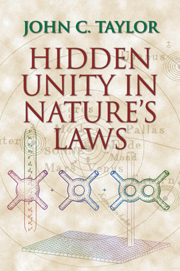Book contents
- Frontmatter
- Contents
- Preface
- 1 Motion on Earth and in the Heavens
- 2 Energy, Heat and Chance
- 3 Electricity and Magnetism
- 4 Light
- 5 Space and Time
- 6 Least Action
- 7 Gravitation and Curved Spacetime
- 8 The Quantum Revolution
- 9 Quantum Theory with Special Relativity
- 10 Order Breaks Symmetry
- 11 Quarks and What Holds Them Together
- 12 Unifying Weak Forces with QED
- 13 Gravitation Plus Quantum Theory – Stars and Black Holes
- 14 Particles, Symmetries and the Universe
- 15 Queries
- APPENDIX A The Inverse-Square Law
- APPENDIX B Vectors and Complex Numbers
- APPENDIX C Brownian Motion
- APPENDIX D Units
- Glossary
- Bibliography
- Index
14 - Particles, Symmetries and the Universe
Published online by Cambridge University Press: 20 January 2010
- Frontmatter
- Contents
- Preface
- 1 Motion on Earth and in the Heavens
- 2 Energy, Heat and Chance
- 3 Electricity and Magnetism
- 4 Light
- 5 Space and Time
- 6 Least Action
- 7 Gravitation and Curved Spacetime
- 8 The Quantum Revolution
- 9 Quantum Theory with Special Relativity
- 10 Order Breaks Symmetry
- 11 Quarks and What Holds Them Together
- 12 Unifying Weak Forces with QED
- 13 Gravitation Plus Quantum Theory – Stars and Black Holes
- 14 Particles, Symmetries and the Universe
- 15 Queries
- APPENDIX A The Inverse-Square Law
- APPENDIX B Vectors and Complex Numbers
- APPENDIX C Brownian Motion
- APPENDIX D Units
- Glossary
- Bibliography
- Index
Summary
Modern cosmology envisages a universe that, at its early moments, was very hot and very small. In these extreme conditions, experience on Earth gives little guide to the behaviour of matter. We must turn to elementary particle physics in an attempt to divine what matter was like. Conversely, as mentioned at the end of the Chapter 12, particle physics has raised questions that are probably beyond laboratory experiments to answer. Maybe evidence from the universe at large can help.
There are two general features of modern particle physics that make application to the early universe particularly interesting.
Both the gluon theory of strong interactions (Chapter 11) and the electroweak theory (Chapter 12) employ some analogies with superconductivity (Chapter 10). As the temperature of a superconducting substance is raised, there is a phase transition above which superconductivity ceases. There are good reasons to believe that something similar should happen to the vacuum of particle physics. At the high temperatures of the early universe, the Bose condensation of Higgs particles should go away, revealing the gauge symmetry in an unbroken form (as in Section 12.4). Likewise, confinement of colour should go, and the gluons behave similarly to photons. Thus the physics of the early universe may have been, in some sense, simpler than physics now.
In non-Abelian gauge theories, coupling strengths decrease as the typical energies explored increase (Section 11.3). In the early universe, the temperature is the relevant energy, so very early, when the temperature is very high, the particles may behave nearly like free ones. Then, in spite of the extreme conditions, physics may not be as difficult as might have been supposed.
- Type
- Chapter
- Information
- Hidden Unity in Nature's Laws , pp. 379 - 409Publisher: Cambridge University PressPrint publication year: 2001



